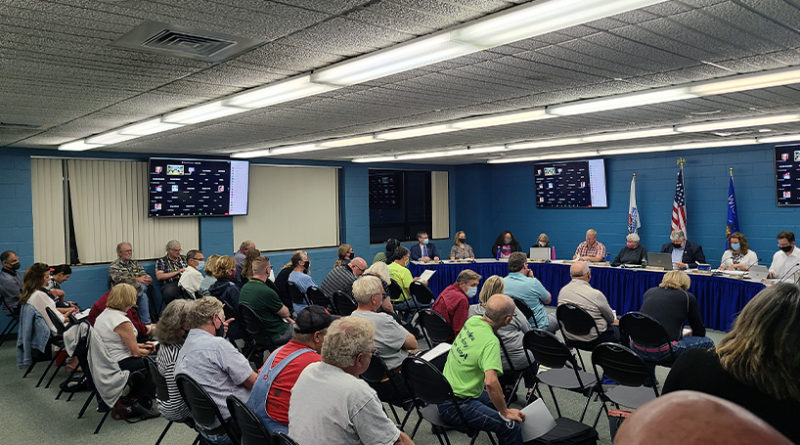City Council votes to approve recommended alternative for Bus. 51
By Brandi Makuski
Roughly two hours of public input had little impact on the City Council’s decision to approve the Bus. 51 project on Monday night, as many members of the council read comments they’d had written out prior to the meeting.
Council members voted on the controversial project at the four-hour-mark of the Sept. 20 meeting, but not before spending several minutes each thanking contractor AECOM and members of the public who attended the standing-room-only meeting.
Many on the Council said they didn’t understand so many claims from residents and business owners who said they hadn’t heard of the Bus. 51 project before now, and many said they were going to vote in favor because AECOM’s recommendations improved safety along the road.
Several members of the public, many from the southside business district, spoke in opposition to the changes, saying the lane reduction will mean less traffic on the city’s arterial roadway, and in turn, fewer customers.
Alderman Shaun Morrow, District 11, said until he was contacted by Goldkey Motors owner Kevin Flatoff, he had no idea that business owners were unaware of the Bus. 51 project and he suggested Flatoff bring southside business owners to the meeting.
“But this is not a vote to approve everything, this is to approve 30 percent of the planning. This is not a final vote and we’re going to start tearing things up on Monday. I think we should proceed because nothing is set in stone,” Morrow said.
Morrow also attempted to ease concerns about a proposed roundabout at Fourth Ave., saying the North Point Dr. roundabout has alleviated traffic congestion at that intersection “wonderfully.”
“People will say, ‘Well, this will slow traffic down,’ but that’s the whole point,” said District 4 Councilwoman Mykeerah Zarazua. “We have a moral and legal obligation to ensure this is a safe way to get through our city. We’re trying to have the least amount of impact on small businesses as possible.”
Council President Meleesa Johnson spoke at length about her reasons for supporting the project, which include supporting the city’s staff and projections of improved safety.
“We could make the corridor a wide four-lane superhighway. That is an option. For me, that isn’t an option. according to our engineers that option comes in at a whopping 52 million and would require significant acquisition,” she said.
Jeremy Slowinski, Alderman for District 6, said he agreed that safety improvements were necessary but he wanted the city and AECOM to rethink the southside business corridor.
“I was here for the first round (the first Bus. 51 proposal in 2014)—it was an absolute disaster,” Slowsinksi said. “The majority of, in my opinion, the opposition [tonight] was the southside business owners. When this came to us in 2019, I pointed out, and I was very adamant about it, that we need to get the business owners involved in the discussion from the start.”
Slowinski said he was “disappointed” and “embarrassed” that so many people said they were unaware of the project.
“I was under the assumption we were going to get business owners involved this time, and now look where we are again tonight,” he said. “I’m so disappointed in this process. I’m embarrassed. The way we ditched on these people on the southside is embarrassing.”
Alderman David Shorr, District 2, said he was “truly sorry” this issue had become so divisive. “We need the federal support to do whatever we’re going to do, and that’s what’s so frustrating about this division.”
Shorr said he believed that the proposal actually did address many of the concerns expressed, adding, “I don’t know why it’s so hard for people to believe that the roundabout would be good for safety. Streets are better when you have to slow down for safety.”
Councilwoman Mary Kneebone, a retired urban planner who represents District 7, also pointed to the safety improvements.
“Right now we have a corridor that panders to cars. We have bicycles, we have people walking, we have moms with strollers. We’re trying to make a corridor that works for everybody. We’re trying to make it safer, and to make it safer, you slow things down,” Kneebone said. “I strongly support the conversion from four to three. One thing I’m hearing is that nobody knew anything. One thing I would like to see is if Director Beduhn would clarify how things were handed out; I don’t think it’s fair to denigrate how things were handled there. I trust AECOM, I trust our public works director, and his staff, to do the right thing for the City of Stevens Point.”
Thomas Leek, District 8, said he agreed with Johnson, saying he personally “came close on several occasions to getting run down” on Division St. and believes slowing down traffic would make it safer.
Mayor Mike Wiza said there was no design that would “specifically preclude” the city from receiving state or federal grant funding for the project, and added that the city was still taking public input and comments.
“It warrants, after tonight’s meeting, that we have an additional public meeting to make people aware of it. It doesn’t mean modifications won’t be made—they will be,” he said.
Voting in favor were Council members Shorr, Ginger Keymer, Zarazua, Johnson, Kneebone, Leek, Poilly Dalton, Keeley Fishler, and Morrow. Slowinski was the sole opposition.
This story will be updated.

